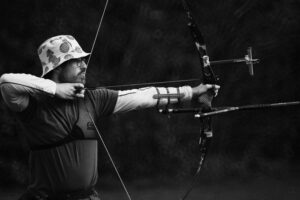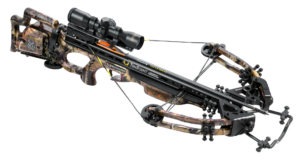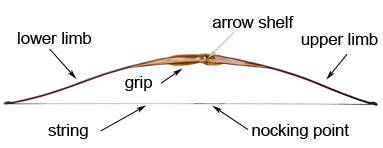The bow and arrow played a big part in human history. From being used as a strategic battle weapon to being a life changer for hunters, the bow and arrow has stamped itself as a versatile tool.
Nowadays, it isn’t used as a weapon during wars, but a bow is still a piece of recreational and hunting equipment growing in popularity, used in everything from summer camps to serious competitions, and is also a method for hunting that proves MUCH more challenging than using a firearm. Over 3 million Americans bowhunt each year.
Archery has also become a major sport among different countries, even for people who have no intention of ever hunting. For example, the Vegas Shoot is the biggest and most prestigious indoor archery tournament in the world. The event brings in over 4,000 competitors from all over to compete. It’s also one of the sports during the Summer Olympics.
Over the course of the history of the bow, there have been several different designs made. In this article, we will discuss the different types of bows, what they are used for, shooting ranges, and design.
What is a Bow?

A bow and arrow is a short-range weapon that was first discovered over 60,000 years ago in South Africa. It has several different uses but originally it was used as a weapon for battle or for hunting.
The bow is made of an arch-like band that has loops on both ends with an elastic string attached. The arrow is then “nocked” or attached to the string. It is drawn back and released, projecting the arrow at its target.
The bow can shoot at different distances depending on the design and type. Typically speaking, a bow can shoot an arrow anywhere from 10 to 500 yards accurately.
Nonetheless, no matter what type of bow you shoot, it takes a lot of practice and persistence to be accurate. Not only is practice important, but there is quite a bit of technique that goes into play with being a good shot.
Types of Bows
Let’s take a look at the different types of bows and their capabilities. Each has a different design, and a different purpose.
Recurve Bow
Dating back to thousands of years, the recurve bow is a survivalist best friend. Crafted with a 3-point shape, the ends of the recurve point towards the target with the string attached. If a child takes an archery course at a summer camp, the odds are they will be using a recurve bow.
The recurve is a light and simple bow, which makes it great for teaching people how to use a bow, as well as any shoot or practice that will require walking long disances with the bow. However, compared to some other types of bows, the recurve doesn’t have great accuracy or power (a good things if you are inexperienced!)
The speed at which the arrow travels when shot from a recurve is dependent on how far the archer can draw back the bow, the design and tension of the bow, and the bowstring used. This is why you will see these often being used at shorter ranges.
For the traditional sportsman, mastery of the recurve bow is a work of art. It takes patience and an immense amount of trial and error to become accurate with the recurve. Nonetheless, it presents a challenge for those who like simplicity. Not only is the recurve very light but it is also low maintenance because of its simple mechanics.
For many of us, the recurve is the first type of bow we were ever handed as a child.
It’s also an inexpensive option. A person can find a well-made recurve under $200, making it a budget buy.
Recommended for:
Beginners, summer camps, backyard target practice where the goal is to build skill versus compete or hunt.
Good Example:
The Galaxy Sage is a good example of a basic but fun recurve bow, the kind that is intuitive to use and a good value for what you get. (Find Here)
Compound Bow

The compound bow has become the bow of choice amongst most hunters and sportsmen because of its increased accuracy and power. That’s not saying that the compound bow doesn’t take constant practice to be a good shot.
When you hear people talking about hunting with a bow, they are talking about a compound bow.
Where the compound bow differs from the recurve bow is that it has a series of pulleys and strings that give the bow much, much more power and speed when launching the arrow. It is also common out outfit a compound bow with sights. Depending on your preference, you can have sights ranging from 10-80 yards. It is common to see the sight pins ranging from 20-60 yards because anything over that takes plenty of skill. Unlike rifle hunting, you really shouldn’t be at hunting binocular-distance when hunting with a bow. It is mostly done in short range.
We mentioned the major difference between the compound bow and the old-school bows being its mechanics. Unlike the recurve, the compound bow uses wheels or cams. This loads up the power when the bowstring is drawn back. When the drawstring is released, the bow projects the arrow at speeds up to 350 feet per second.
Not only is the compound bow more accurate and powerful, but it is also more customizable. Sportsmen and hunters can add accessories to their bows such as stabilizers, scopes, noise reducers, and arrow stands. With a good outfit of gear – a good jacket, hunting boots, and a stand — you can travel pretty light and stealthy when bowhunting and have everything you need..
Like everything else on the market, compound bows are becoming incredibly high-tech. Most compound bows are made of aluminum or carbon fiber. These materials make them durable, but light enough to pack in the field or to hold for long periods in a tree stand. The typical length for the hunting bows ranges from 17 to 28 inches long whereas the competition compound bows are longer ranging upwards of 40 inches long.
The compound bow is the most popular pick for competition and hunting. The pricing can vary, depending on the brand, year, and features. Buying a compound bow is like buying a car, you can make them as fancy and accessorized as you like.
A person can find a new bow starting at just under $500, but depending on what you’re looking for, it can be well over $1,000.
Recommended For:
Hunting, and high-velocity target shooting where millimeters matter.
Good Example:
The Hoyt Torrex is widely seen as a great all-around compound bow. It has a smooth draw, is lightweight, and a real nice-shooting bow. (Find Here)
Crossbow

If we had a list of the bows from simplest to most complicated, a crossbow would be on the complicated end. A crossbow is an interesting bow that has a design that is mixed with a bow and a gun. Unlike, the recurve and compound bow, the crossbow isn’t held vertical. Instead, it is held like a gun with it close to your body.
It still uses a string to project the arrow, however, instead of you letting go of the string, the arrow is released by pressing a trigger like a gun.
Even though the crossbow may seem like new technology, archeologists have actually found it over 2,500 years ago. There have also been writings that have mentioned weapons resembling a crossbow in the early 300’s A.D.
Similar to the compound and recurve bow, the crossbow is still used for hunting and competition.
Crossbows shoot arrows at fast speeds up to 400 fps, they are also capable of shooting the farthest at ranges up to 500 yards. For treestand or blind hunting, bowhunters can shoot at targets at long distances. Because of the speed and power, beginners shouldn’t even think of using a crossbow. They are for experienced shooters and niche uses.
Since they are a mix between a rifle and a bow, it is common for crossbows to be equipped with a scope. Once these weapons are sighted in, they can be quite accurate and effective.
Compared to the compound bow, the crossbow is heavier, not making it ideal to pack around on a hunt. However, they aren’t nearly as expensive, you can typically find a decent crossbow setup starting at $250.
Recommended For:
Hunting and precision shooting. Often an option where the sound of a gun would be too loud, such as precision shooting competition at an urban setting.
Good Example:
The Ten Point Turbo S1 is probably our favorite combination of value and performance. A good all around crossbow at about half the cost of what you could pay. (Find Here)
Longbow
Longbows (or straight bows) are similar to recurves in the sense that they are both a type of traditional bow. Additionally, they both take a lot of practice and strength to shoot accurately.

A longbow has a slightly different design, where it has a D-shape whereas the recurve makes a 3-point shape. They are light and typically made with a single piece of wood that has a slight bend to it.
During the time when longbows were used in wars, they were effective weapons up to 300 yards! That’s pretty impressive for the technology that was available during those times.
For hunting and competition, the modern longbow can be accurate from 60-80 yards. However, shooting accurately at this distance will take time.
The longbow doesn’t seem to hold the same power as the recurve because of the recurves capability of loading power in its limbs. Nonetheless, the longbow is quieter and known to have a smoother draw out of the two.
You can purchase a quality longbow for under $200. The nice thing about the purchase is that besides arrows, that’s all you really need to starting shooting. Just be sure you don’t attempt to string a longbow like a crossbow — you will break it.
Recommended For:
Old school archery, people who appreciate doing things the old way. The right longbow can also make a great wall decoration.
Good Example:
The SAS Pioneer is a classic longbow design, and a good option for those who want a bow that looks the part of the wild west. (Here on Amazon)
Bow FAQs
Bows have a strong place in our history, and remain a fun activity for hunters and athletes alike. Which bow fits your needs, wants, and interests?
Which bow is best for beginners?
A recurve or a longbow is best for beginners. A recurve is probably the most common option for beginners, and the one most kids at an archery class will learn on. You can have lots of fun doing target practice with a recurve bow.
The pros of a recurve bow are that it is intuitive to use, there isn’t a lot of maintenance, and it can teach someone the basics of archery (kind of like a simple aluminum canoe can teach someone the basics of paddling).
The downside of a recurve bow is that it is not suited for hunting or some competitions, so if you think that you will in short order be getting serious about archery, think about that. However, a recurve bow is great to learn on and honestly any archer should have one.
Which bow is best for hunting?
The compound bow is best for hunting. For hunting, you need a bow that can drive an arrow with enough force to effectively hunt. Because of how it is designed, a compound bow can punch above its weight in terms of the power it can put behind an arros.
Crossbows can work for hunting too, but you will want to check with your state regulations. Not all are legal for hunting in every state.
Are bows capable of being lethal?
Yes, you have to be careful with them and it is importantly to be properly trained on using a bow. Especially with compound bows or crossbows, a careless user or an errant arrow can seriously hurt or kill someone. Recurve and longbows don’t have the same power, but they still can inflict serious injury.
How do I hunt with a bow?
Bowhunting is a popular activity among the hunting crowd, but it is a hard question to answer because each state has different bowhunting rules. Learn the rules in the state you would like to hunt in, including the appropriate ages, required training, and the season for hunting various game. Also, always do research on the place you want to hunt to make sure you have permission to hunt there. We do not condone trespassing — good hunters make sure they have explicit permission and can conduct a safe hunt.








Love this post! As an archer myself, it’s great to see the different types of bows and their unique characteristics. The grip type especially caught my attention, as I’ve never really thought about how important it is in determining the comfort and control of the bow. Can’t wait to try out some of these different types and see which one works best for me!